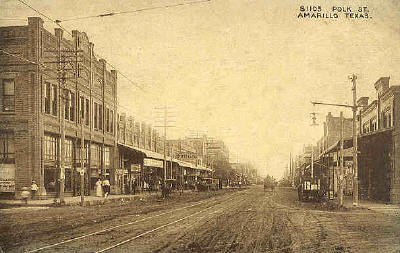|
| Santa
Fe Train Number One, with a 3751-class 4-8-4 steam engine up front,
pulled up to the red-roofed, Mission revival-style Amarillo
station on time. |
The Sante Fe
Depot in Amarillo
circa 1910
Photo courtesy texasoldphotos.com |
One of the people
stepping off the train at the busy depot was William Gibson, a Santa
Fe employee traveling on a company pass.
With his small suitcase in one hand and his well-worn tool and instrument
valise in the other, Gibson walked from the station to the nearby
Capitol
Hotel at Fourth and Pierce. The Herring,
across the street, was a bigger hotel, but Gibson liked the 200-room
Capitol. At the front desk, Gibson went through a familiar routine:
He asked for a south-side room on the fourth floor or higher.
|
"Capitol
Hotel in Amarillo, razed in the 1970s"
Photo courtesy Wes Reeves |
Hotel Herring
TE postcard archive |
|
As soon as he
closed the door behind him, Gibson walked to the window and looked
out. His room, as he knew it would, looked down on the busy Santa
Fe yard. The roundhouse had 32 train stalls and almost always was
full. In the distance, Gibson saw a plume of black smoke as a freight
train hit an eastbound grade on a big curve. After taking in the
view for a moment, he raised the window a few inches. It opened
easily — wood did not often swell with moisture on the High Plains.
At nearly 3,700 feet above sea level, spring and summer nights usually
are cool and humidity-free.
On this night, the wind blew strong from the southeast, sucking
through the cracked window. Gibson liked the fresh night air, but
he had opened the window more to let in sound.
Number One had boarded its Amarillo
passengers and was moving slowly through the Amarillo
yard. Gibson checked his watch. It was still on time. Her hogger
— railroad talk for engineer — blasted the whistle as the train
headed toward the 24th Street crossing.
|
 |
Polk Street in
the early 1900s
Photo courtesy texasoldphotos.com |
One
long, two shorts, and then a continuous blast until the engine cleared
the crossing. The shrill sound created by the high-pressure steam
echoed off the concrete grain elevators lining the tracks and the
high rise office buildings along busy Polk Street. The whistle was
music to the railroad man’s ears. With tongue-in-cheek, he called
it the “Amarillo Symphony.”
Periodically through the night, other trains moved in and out of Amarillo
as most of the city slept. In addition to the Santa Fe track, main
lines of the Fort Worth and Denver and the Rock Island Line intersected
at Amarillo. The
piercing notes of train whistles spread across the city and cut onto
the vastness of the plains. |
Fort Worth and
Denver Depot in Amarillo
circa 1910
Photo courtesy texasoldphotos.com |
The Rock Island
Depot in Amarillo
Postcard courtesy rootsweb.com/ %7Etxpstcrd/ |
For several generations
of Amarilloans, the whistle signals of the steam engine either comforted
them at night like a homemade quilt or haunted their dreams. For some,
the whistles made good company, dispelling any sense of isolation;
others heard the trains and felt lonesome, remembering or imagining
trips taken or not taken. For all Amarilloans, those whistles — long
since replaced by more prosaic air horns — represent the sound of
a city’s history.
Amarillo is the
largest city in Texas owing its existence
solely to the railroad. Houston,
Dallas, San
Antonio, El
Paso, Fort Worth
and Austin all had other
reasons to be, though railroads certainly benefited each. But Amarillo
would not exist, or if it did it probably would not have amounted
to much, had it not been for the iron.
© Mike Cox
"Texas Tales" November
3, 2005 column |
Forum:
Subject: Depot Identified
I enjoyed looking at photos and postcards of Texas RR Depots on your
website. However, in [Mike Cox's article] "Amarillo Symphony" - regarding
train depots in Amarillo, the depot [photo] marked 'Pecos Valley'
is actually the Fort Worth & Denver RR Depot. The Pecos Valley Southern
RR runs south from Pecos,
Texas (towards Balmorhea.)
- Clif Jones, Bastrop, Texas, July 09, 2006 |
| Books
by Mike Cox - Order Here |
|
|
